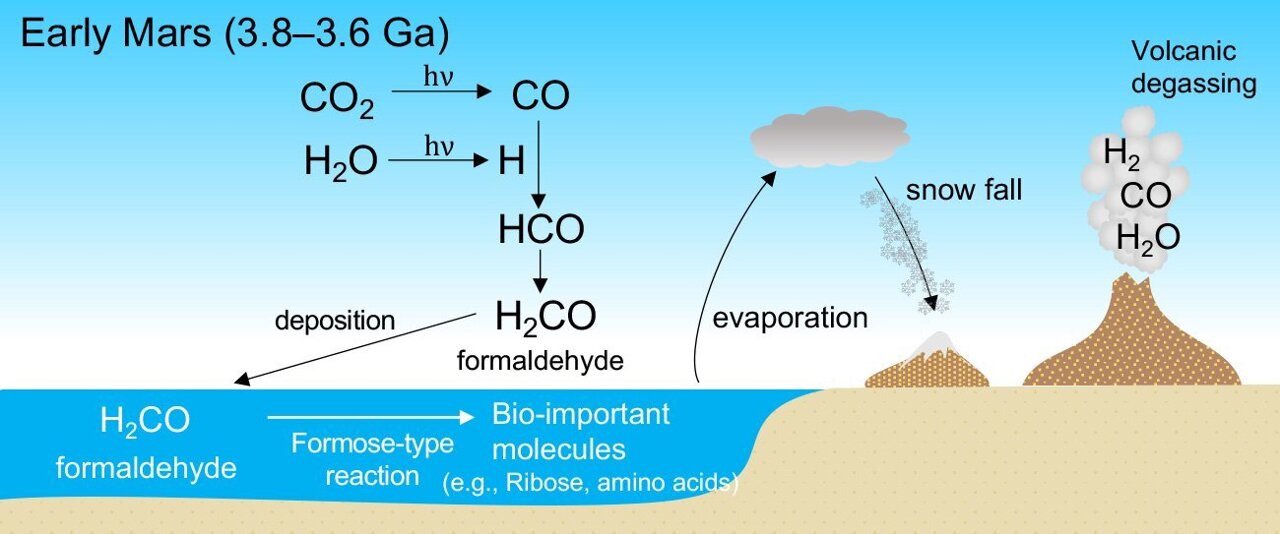Deciphering the Origins of Martian Organic Matter: A Glimpse into Ancient Life
Unveiling the mysteries of the cosmos, recent studies have shed light on the potential origins of organic matter on Mars, suggesting a past that may have been ripe for life. Researchers at Tohoku University have delved into the atmospheric conditions of ancient Mars, proposing that formaldehyde could have been a key player in the synthesis of life’s building blocks. This groundbreaking research, published in Scientific Reports, not only enhances our comprehension of the Red Planet’s history but also ignites curiosity about the existence of life beyond Earth.
Unlocking the Secrets of the Red Planet: Could Mars Have Been a Cradle for Life?
Early Martian Climate and Potential for Life
Long ago, the Martian landscape may have been a sanctuary for life, with a climate that was considerably more clement than the arid and frigid conditions we observe today. Geological traces suggest that around 3.8 to 3.6 billion years ago, Mars was likely a warm and wet world, with a thick atmosphere that could have supported life. This period of Martian history, marked by a temperate climate, was possibly sustained by greenhouse gases such as hydrogen, creating an environment where life could potentially flourish.
Within this ancient context, the presence of liquid water, a vital component for life as we understand it, was highly probable. The implications of such a hospitable past are profound, hinting at the potential for life to have once existed on the now barren Martian surface.
The Role of Formaldehyde in Martian Biomolecule Formation
The Tohoku University team focused on the possibility that formaldehyde, a simple yet significant organic compound, could have been synthesized in the atmosphere of early Mars. This compound is known to be a precursor to more complex biomolecules, which are the cornerstones of life, including amino acids and sugars. These substances are indispensable for the construction of proteins and RNA, which are the very fabric of living organisms.
Through their research, the scientists explored the likelihood that formaldehyde could have been a stepping stone to the formation of these essential biomolecules, potentially through non-biological processes. The existence of such compounds on ancient Mars would have been a crucial element in the planet’s ability to support life.
Simulation Insights into Ancient Mars’ Atmosphere
Employing sophisticated computer modeling, the researchers simulated the atmospheric conditions of ancient Mars to assess the feasibility of formaldehyde production. The model incorporated the premise that the Martian atmosphere was once rich in carbon dioxide, hydrogen, and other gases. The results of these simulations were revealing, indicating that the ancient atmosphere of Mars could have been a source of a steady supply of formaldehyde.
This continuous generation of formaldehyde would have set the stage for the creation of a variety of organic compounds. Such a discovery supports the tantalizing theory that the organic materials found on the Martian surface today may have atmospheric origins, particularly during the planet’s earliest geological epochs.
Implications for Astrobiology and Future Research
Lead author Shungo Koyama and his team have provided pivotal insights into the chemical processes that might have taken place on ancient Mars. These findings offer valuable hints at the planet’s former ability to harbor life and expand our understanding of Mars’ ancient environment. The research not only contributes to the field of astrobiology but also raises questions about the broader potential for life in the universe.
Looking ahead, the team is set to analyze geological data collected by NASA’s Martian rovers. Their goal is to deepen their understanding of the organic materials that were present in the early history of the planet. By comparing the expected carbon isotopes from ancient formaldehyde with the data obtained from Martian samples, they aim to further unravel the complex organic chemistry of Mars and its implications for past life.
